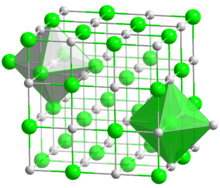 Lithium cation, Li+ Hydrogen anion, H− | |
 __H− __Li+
Structure of lithium hydride. | |

| |
| Identifiers | |
|---|---|
3D model (JSmol)
|
|
| ChemSpider | |
| ECHA InfoCard | 100.028.623 |
PubChem CID
|
|
| RTECS number |
|
| UNII | |
CompTox Dashboard (EPA)
|
|
| |
| |
| Properties | |
| LiH | |
| Molar mass | 7.95 g·mol−1 |
| Appearance | colorless to gray solid[1] |
| Density | 0.78 g/cm3[1] |
| Melting point | 688.7 °C (1,271.7 °F; 961.9 K)[1] |
| Boiling point | 900–1,000 °C (1,650–1,830 °F; 1,170–1,270 K) (decomposes)[2] |
| reacts | |
| Solubility | slightly soluble in dimethylformamide reacts with ammonia, diethyl ether, ethanol |
| −4.6·10−6 cm3/mol | |
Refractive index (nD)
|
1.9847[3]: 43 |
| Structure | |
| fcc (NaCl-type) | |
a = 0.40834 nm[3]: 56
| |
| 6.0 D[3]: 35 | |
| Thermochemistry | |
Heat capacity (C)
|
3.51 J/(g·K) |
Std molar
entropy (S⦵298) |
170.8 J/(mol·K) |
Std enthalpy of
formation (ΔfH⦵298) |
−90.65 kJ/mol |
Gibbs free energy (ΔfG⦵)
|
−68.48 kJ/mol |
| Hazards | |
| Occupational safety and health (OHS/OSH): | |
Main hazards
|
extremely strong irritant, highly toxic, highly corrosive |
| GHS labelling: | |
  
| |
| Danger | |
| H260, H301, H314 | |
| P223, P231+P232, P260, P264, P270, P280, P301+P316, P301+P330+P331, P302+P335+P334, P302+P361+P354, P304+P340, P305+P354+P338, P316, P321, P330, P363, P370+P378, P402+P404, P405, P501 | |
| NFPA 704 (fire diamond) | |
| 200 °C (392 °F; 473 K) | |
| Lethal dose or concentration (LD, LC): | |
LD50 (median dose)
|
77.5 mg/kg (oral, rat)[5] |
LC50 (median concentration)
|
22 mg/m3 (rat, 4 h)[6] |
| NIOSH (US health exposure limits): | |
PEL (Permissible)
|
TWA 0.025 mg/m3[4] |
REL (Recommended)
|
TWA 0.025 mg/m3[4] |
IDLH (Immediate danger)
|
0.5 mg/m3[4] |
| Safety data sheet (SDS) | ICSC 0813 |
| Related compounds | |
Other cations
|
Sodium hydride Potassium hydride Rubidium hydride Caesium hydride |
Related compounds
|
Lithium borohydride Lithium aluminium hydride |
Except where otherwise noted, data are given for materials in their standard state (at 25 °C [77 °F], 100 kPa).
| |
Lithium hydride is an inorganic compound with the formula LiH. This alkali metal hydride is a colorless solid, although commercial samples are grey. Characteristic of a salt-like (ionic) hydride, it has a high melting point, and it is not soluble but reactive with all protic organic solvents. It is soluble and nonreactive with certain molten salts such as lithium fluoride, lithium borohydride, and sodium hydride. With a molar mass of 7.95 g/mol, it is the lightest ionic compound.
- ^ a b c Lide, D. R., ed. (2005). CRC Handbook of Chemistry and Physics (86th ed.). Boca Raton (FL): CRC Press. p. 4.70. ISBN 0-8493-0486-5.
- ^ David Arthur Johnson; Open University (12 August 2002). Metals and chemical change. Royal Society of Chemistry. pp. 167–. ISBN 978-0-85404-665-2. Retrieved 1 November 2011.
- ^ a b c Smith, R. L.; Miser, J. W. (1963). Compilation of the properties of lithium hydride. NASA.
- ^ a b c NIOSH Pocket Guide to Chemical Hazards. "#0371". National Institute for Occupational Safety and Health (NIOSH).
- ^ Chambers, Michael. "ChemIDplus - 7580-67-8 - SIAPCJWMELPYOE-UHFFFAOYSA-N - Lithium hydride - Similar structures search, synonyms, formulas, resource links, and other chemical information". chem.sis.nlm.nih.gov. Retrieved 10 April 2018.
- ^ "Lithium hydride". Immediately Dangerous to Life or Health Concentrations (IDLH). National Institute for Occupational Safety and Health (NIOSH).
